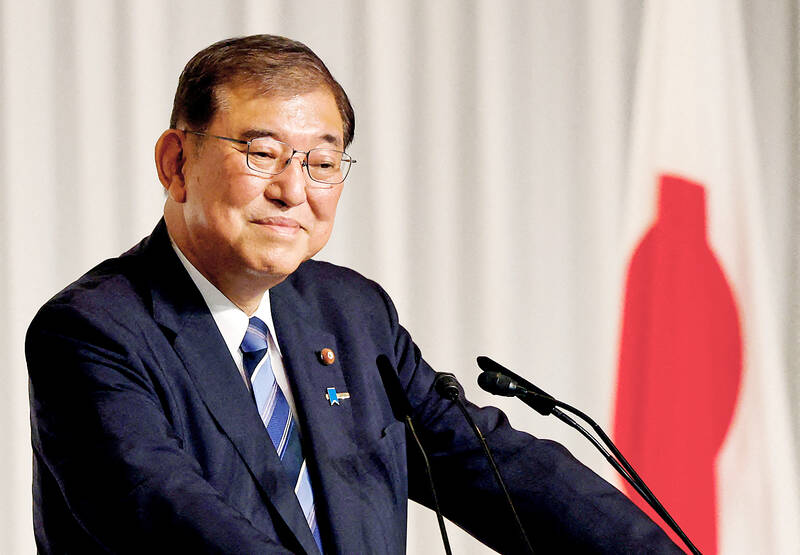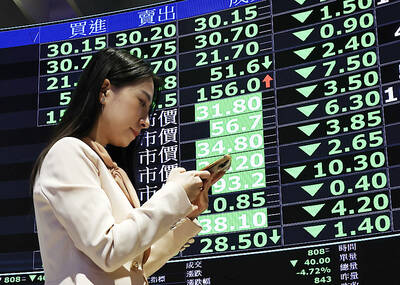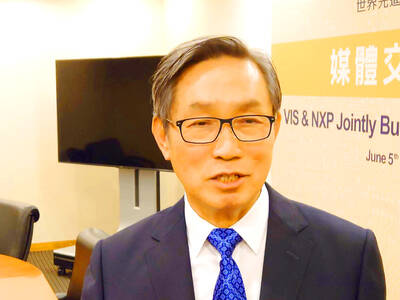Japan’s incoming prime minister, Shigeru Ishiba, yesterday said that the country’s monetary policy must remain accommodative as a trend, signaling the need to keep borrowing costs low to underpin a fragile economic recovery.
It was not immediately clear whether Ishiba, who had been a vocal critic of the Bank of Japan’s (BOJ) past aggressive monetary easing, was taking a more dovish line with his remarks.
“It’s something the Bank of Japan, which is mandated to achieve price stability, will decide while working closely with the government,” Ishiba told public broadcaster NHK, when asked about further interest rate increases by the central bank.

Photo: Reuters
“From the government’s standpoint, monetary policy must remain accommodative as a trend given current economic conditions,” he said.
On fiscal policy, Ishiba said he would aim to compile a package of measures at an early date to cushion the economic blow from rising living costs, with a focus on helping low-income households.
Ishiba, a former defense minister, is set to become prime minister tomorrow after winning the presidency of the ruling Liberal Democratic Party on Friday.
After his victory, Ishiba said monetary policy would broadly remain loose but suggested he would not push back against further increases in still near-zero interest rates.
The BOJ ended negative interest rates in March and raised short-term borrowing costs to 0.25 percent in July in a landmark shift away from a decade-long, radical stimulus program.
BOJ Governor Kazuo Ueda has signaled a readiness to raise rates further if Japan makes progress toward durably achieving the bank’s 2 percent inflation target, as the board projects it would.
Ishiba told Reuters last month that the BOJ was on the “right policy track” by ending negative rates and endorsed further normalization of monetary policy, saying it could boost industrial competitiveness. However, in an interview this month, he said Japan must prioritize making a full exit from deflation and warned of weak signs in consumption.
Former minister of health, labor and welfare Katsunobu Kato is set to become Japan’s next finance minister, according to Kyodo News, replacing Shunichi Suzuki to take on the job of steering the country’s finances through a period of economic change.
Kato helped guide Japan through the COVID-19 pandemic, when the country fared better than most of its G7 peers. The 68-year-old has played key roles in recent administrations and was a Ministry of Finance official before going into politics.
Kato would be taking on one of the highest-profile positions in the Cabinet, overseeing a range of policies from currency to budgets. Among the challenges he would face is Japan’s perennial problem of the largest debt load among advanced economies. The debt problem is set to become more complicated as the BOJ slowly moves toward more interest rate hikes, which would keep increasing debt-servicing payments.
In a Bloomberg interview last month, Kato said Japan should continue to aim for interest rates and prices to “keep moving.”
He said years of stagnant prices and rates “created structural distortions.” Kato has advocated for a balanced approach to managing fiscal health and seeking growth.
Kato’s predecessor Suzuki repeatedly said the government should watch the impact from rising yields on debt-servicing costs, warning that higher yields could weigh on finances.
Japan’s debt reached 255 percent of its GDP this year, according to the International Monetary Fund.
Additional reporting by Bloomberg

TARIFFS: The global ‘panic atmosphere remains strong,’ and foreign investors have continued to sell their holdings since the start of the year, the Ministry of Finance said The government yesterday authorized the activation of its NT$500 billion (US$15.15 billion) National Stabilization Fund (NSF) to prop up the local stock market after two days of sharp falls in reaction to US President Donald Trump’s new import tariffs. The Ministry of Finance said in a statement after the market close that the steering committee of the fund had been given the go-ahead to intervene in the market to bolster Taiwanese shares in a time of crisis. The fund has been authorized to use its assets “to carry out market stabilization tasks as appropriate to maintain the stability of Taiwan’s

STEEP DECLINE: Yesterday’s drop was the third-steepest in its history, the steepest being Monday’s drop in the wake of the tariff announcement on Wednesday last week Taiwanese stocks continued their heavy sell-off yesterday, as concerns over US tariffs and unwinding of leveraged bets weighed on the market. The benchmark TAIEX plunged 1,068.19 points, or 5.79 percent, to 17,391.76, notching the biggest drop among Asian peers as it hit a 15-month low. The decline came even after the government on late Tuesday authorized the NT$500 billion (US$15.2 billion) National Stabilization Fund (國安基金) to step in to buoy the market amid investors’ worries over tariffs imposed by US President Donald Trump. Yesterday’s decline was the third-steepest in its history, trailing only the declines of 2,065.87 points on Monday and

TARIFF CONCERNS: The chipmaker cited global uncertainty from US tariffs and a weakening economic outlook, but said its Singapore expansion remains on track Vanguard International Semiconductor Corp (世界先進), a foundry service provider specializing in producing power management and display driver chips, yesterday withdrew its full-year revenue projection of moderate growth for this year, as escalating US tariff tensions raised uncertainty and concern about a potential economic recession. The Hsinchu-based chipmaker in February said revenues this year would grow mildly from last year based on improving supply chain inventory levels and market demand. At the time, it also anticipated gradual quarter revenue growth. However, the US’ sweeping tariff policy has upended the industry’s supply chains and weakened economic prospects for the world economy, it said. “Now

Six years ago, LVMH’s billionaire CEO Bernard Arnault and US President Donald Trump cut the blue ribbon on a factory in rural Texas that would make designer handbags for Louis Vuitton, one of the world’s best-known luxury brands. However, since the high-profile opening, the factory has faced a host of problems limiting production, 11 former Louis Vuitton employees said. The site has consistently ranked among the worst-performing for Louis Vuitton globally, “significantly” underperforming other facilities, said three former Louis Vuitton workers and a senior industry source, who cited internal rankings shared with staff. The plant’s problems — which have not